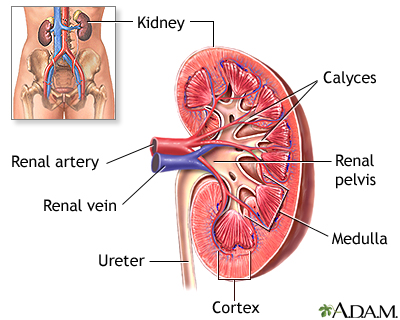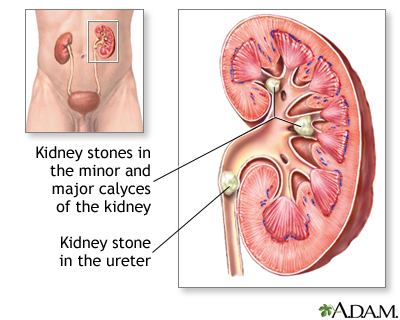Health Topics
You had a procedure to drain urine from your kidney or to get rid of kidney stones. This article gives you advice on what to expect after the procedure and steps you should take to care for yourself.

When You're in the Hospital
You had percutaneous (through the skin) urinary procedures to help drain urine from your kidney and get rid of kidney stones.
If you had a percutaneous nephrostomy, the health care provider inserted a small, flexible catheter (tube) through your skin into your kidney to drain your urine.
If you also had percutaneous nephrostolithotomy (or nephrolithotomy), the provider passed a small medical instrument through your skin into your kidney. This was done to break up or remove kidney stones.

What to Expect at Home
You may have some pain in your back for the first week after the catheter was inserted into the kidney. Over-the-counter pain medicine such as Tylenol may help with the pain. Other pain medicines, such as aspirin or ibuprofen (Advil) can also help, but your provider may recommend you not to take these medicines because they can increase your risk for bleeding.
You may have some clear-to-light yellow drainage around the catheter insertion site for the first 1 to 3 days. This is normal.
A tube that comes from your kidney will pass through the skin on your back. This helps the urine flow from your kidney into a bag that is attached to your leg. You may see some blood in the bag at first. This is normal and should clear over time.
Caring for Your Tubes and Catheters
Proper care of your nephrostomy catheter is important so you do not get an infection.
- During the day, you may use a small urinary bag that is attached to your leg.
- Use a larger drainage bag at night if recommended by your provider.
- Always keep the urinary bag below the level of your kidneys.
- Empty the bag before it is completely full.
- Wash your drainage bag once a week using a solution of half white vinegar and half water. Rinse it well with water and allow it to air dry.
Drink plenty of liquids (2 to 3 liters) every day, unless your provider tells you not to do so.
Avoid any activity that causes a pulling sensation, pain around the catheter, or kinking in the catheter. Do not swim when you have this catheter.
Your provider will recommend that you take sponge baths so that your dressing stays dry. You may take a shower if you wrap the dressing with plastic wrap and replace the dressing if it gets damp. Do not soak in a bathtub or hot tub.
Dressing Changes
Your provider will show you how to place a new dressing. You may need assistance since the dressing will be on your back.
Change your dressing every 2 to 3 days for the first week. Change it more often if it gets dirty, wet, or becomes loose. After the first week, change your dressing once a week, or more often as needed.
You will need some supplies when you change your dressing. These include: Telfa (the dressing material), Tegaderm (the clear plastic tape), scissors, split gauze sponges, 4-inch x 4-inch (10 cm x 10 cm) gauze sponges, tape, connecting tube, hydrogen peroxide, and warm water (plus a clean container to mix them in), and a drainage bag (if needed).
Always wash your hands well with soap and water before you remove the old dressing. Wash them again before you put on the new dressing.
Be careful when you take off the old dressing:
- Do not pull on the drainage catheter.
- If there is a plastic ring keep it against your skin.
- Check to see that the sutures (stitches) or the device that holds your catheter against your skin is secure.
When the old dressing is off, gently clean the skin around your catheter. Use a cotton swab soaked with a solution of half hydrogen peroxide and half warm water. Pat it dry with a clean cloth.
Look at the skin around your catheter for any increase in redness, tenderness, or drainage. Contact your provider if you notice these changes.
Place a clean dressing the way your provider showed you.
If possible, have family or a friend change the dressing for you. This makes the process easier.
When to Call the Doctor
Contact your provider if you have any of these symptoms:
- Pain in your back or side that will not go away or is getting worse
- Blood in your urine after the first few days
- Fever and chills
- Vomiting
- Urine that smells bad or looks cloudy
- Worsening redness or pain of the skin around the tube
Also contact your provider if:
- The plastic ring is pulling away from your skin.
- The catheter has pulled out.
- The catheter stops draining urine into the bag.
- The catheter is kinked.
- Your skin under the tape is irritated.
- Urine is leaking around the catheter or plastic ring.
- You have redness, swelling, or pain where the catheter comes out of your skin.
- There is more drainage than usual on your dressings.
- The drainage is bloody or contains pus.
Alternative Names
Percutaneous nephrostomy - discharge; Percutaneous nephrostolithotomy - discharge; PCNL - discharge; Nephrolithotomy - discharge; Percutaneous lithotripsy - discharge; Endoscopic lithotripsy - discharge; Kidney stent - discharge; Ureteric stent - discharge; Renal calculi - nephrostomy; Nephrolithiasis - nephrostomy; Stones and kidney - self-care; Calcium stones - nephrostomy; Oxalate stones - nephrostomy; Uric acid stones - nephrostomy
Images
References
Bushinsky DA. Nephrolithiasis. In: Goldman L, Cooney KA, eds. Goldman-Cecil Medicine. 27th ed. Philadelphia, PA: Elsevier; 2024:chap 111.
Matlaga BR, Krambeck AE. Surgical management for upper urinary tract calculi. In: Partin AW, Dmochowski RR, Kavoussi LR, Peters CA, eds. Campbell-Walsh-Wein Urology. 12th ed. Philadelphia, PA: Elsevier; 2021:chap 94.
Review Date 9/2/2024
Updated by: Kelly L. Stratton, MD, FACS, Associate Professor, Department of Urology, University of Oklahoma Health Sciences Center, Oklahoma City, OK. Also reviewed by David C. Dugdale, MD, Medical Director, Brenda Conaway, Editorial Director, and the A.D.A.M. Editorial team.





